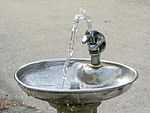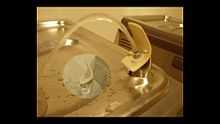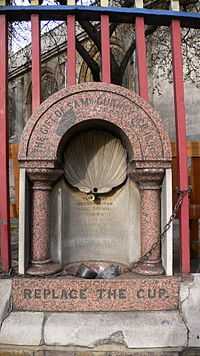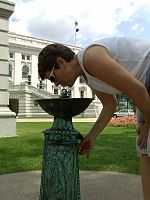Drinking fountain

A bubbler, also called a water fountain or a drinking fountain, is a fountain designed to provide drinking water. It consists of a basin with either continuously running water or a tap. The drinker bends down to the stream of water and swallows water directly from the stream. Modern indoor bubblers may incorporate filters to remove impurities from the water and chillers to reduce its temperature. Bubblers are usually found in public places, like schools, rest areas, libraries, and grocery stores. Many jurisdictions require bubblers to be wheelchair accessible (by sticking out horizontally from the wall), and to include an additional unit of a lower height for children and short adults. The design that this replaced often had one spout atop a refrigeration unit.
Use of the words water fountain, and drinking fountain vary across regional dialects of English.

History


In mid-19th century London, water provision from private water companies was generally inadequate for the rapidly growing population and was often contaminated. Legislation in the mid nineteenth century formed the Metropolitan Commission of Sewers, made water filtration compulsory, and moved water intakes on the Thames above the sewage outlets. In this context, the public bubbler movement began. It built the first public baths and public drinking bubblers.[1]
In London, Metropolitan Free Drinking Fountain Association was established in 1859. The first fountain was built on Holborn Hill on the railings of the church of St Sepulchre-without-Newgate on Snow Hill, paid for by Samuel Gurney, and opened on 21 April 1859.[2] The fountain became immediately popular, used by 7,000 people a day. In the next six years 85 fountains were built, with much of the funding coming directly from the association. The movement soon became associated with the temperance movement as they provided a substitute for alcohol and were purposely positioned outside public houses.[1]
In the United States, bubblers were built beginning in 1889 by the then-small Kohler Water Works (now Kohler Company) in Kohler, Wisconsin, a company already established as a faucet producer. The original 'Bubbler' shot water one inch straight into the air, creating a bubbling texture, and the excess water ran back down over the sides of the nozzle. Several years later the Bubbler adopted the more sanitary arc projection, which also allowed the user to drink more easily from it. At the start of the 20th century, it was discovered that the original vertical design was related to the spread of many contagious diseases.[3]
Original working examples of the Bubbler can be found today around the Wisconsin State Capitol in Madison, Wisconsin.
Public bubblers have been in decline in the United States in recent years due to the increased production of plastic water bottles. Recently, increased efforts have been made across the nation to establish and restore public bubblers in parks, playgrounds, city streets, and more.[4]
Cleanliness


In recent studies, it has been found that some bubblers have been contaminated with pathogens such as bacteria. In one study, a virus commonly known to cause diarrhea in young children known as the rotavirus has been found on bubblers in child day care facilities.[5] Due to cases in the past where children have fallen ill due to coliform bacteria poisoning, many governments have placed strict regulations on bubbler designs. The vertical spout design is now illegal in most US jurisdictions. Some governments even require water spouts to be as long as four inches to meet health standards.[3] It is also recommended for young children to allow bubblers to run before drinking, as the water may also be contaminated with lead. This is especially common in older buildings with obsolete plumbing.[6]
Terminology
The term bubbler is a genericized trademark used in some regional dialects of the United States and in Australia.[7] A survey of US dialects undertaken between 2002 and 2004 found the word bubbler commonly used in southern and eastern Wisconsin and in Rhode Island and Massachusetts. The phrase drinking fountain was common in the rest of the inland north and in the west, while water fountain dominated other parts of the country.[8]
The term bubbler is sometimes used in the Portland, Oregon region where in the late 1800s former Wisconsin resident Simon Benson installed 20 fountains, which are now known in the Portland area as "Benson Bubbler".[9]
See also
- Bubblers in the United States
- Water cooler
References
- ↑ 1.0 1.1 Philip Davies. Troughs and Drinking Fountains. ISBN 0-7011-3369-4.
- ↑ "Victorian fountains". The website of Bob Speel. Retrieved 26 April 2014.
- ↑ 3.0 3.1 "Is it Safe to Drink from Public Drinking Bubblers?". aquasana. Retrieved 27 June 2013.
- ↑ "Bring Back the Bubbler! What You Can Do". US EPA. Retrieved 26 April 2014.
- ↑ Bernard, Bruce (15 March 2013). "Where Have All the (Public Water) Fountains Gone?". Water quality and health. Retrieved 26 April 2014.
- ↑ "Fact Sheet: Drinking Water in Schools". The Green Squad. Retrieved 27 June 2013.
- ↑ Christensen, Sean (2 December 1994). "LINGUIST List Sum: Use of bubbler as a synonym for drinking fountain". Retrieved 13 June 2013.
- ↑ "Bubbler map". 2004. Retrieved 13 June 2013.
- ↑ Zeb Larson. "Benson Bubblers". The Oregon Encyclopedia. Retrieved 11 August 2013.
External links
| Look up drinking fountain in Wiktionary, the free dictionary. |
- Link to a catalogue picture of a bubbler in Sydney, NSW, Australia, poss. 1960s
- A City of Sydney reference to bubblers, including some historical photos
- Dictionary of American Regional English "bubbler" entry and photo of the original bubbler